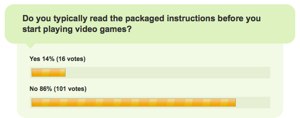
Flickr Photo by Sharyn Morrow
I keep getting reminded that many of the people in my audiences are not of my generation, though I suspect that this is more true of those who read my blog or follow me on Twitter than those who sit politely in front of me. I was reminded of a generational gap over the past few days as I have conducted a Twitter poll using polldaddy. The question…
Do you typically read the packaged instructions before you start playing video games?
86% indicated that they do not read the instructions but simply start playing the game, learning along the way. This was out of 117 respondents. I asked my son if he reads the instructions and he said, “No!” and that he didn’t know anyone his age who did. If you think about it, ask your students how many of them play their game only after reading the instructions, or if they just start playing. Comment here if you have time.
 Of course the respondents of my survey were probably not a good cross sampling as they were Twitter users, who follow me — a suspect group from the start. But still, when I am presenting to a school district, it is a far more representative audience. Often someone asks the attendees to identify their generation, and a vast majority, typically about 80%, will stand up as Boomers.
Of course the respondents of my survey were probably not a good cross sampling as they were Twitter users, who follow me — a suspect group from the start. But still, when I am presenting to a school district, it is a far more representative audience. Often someone asks the attendees to identify their generation, and a vast majority, typically about 80%, will stand up as Boomers.
The best corollary I can think of for my gen is board games, and you simply could not play most board games without having read the instructions. So what’s the difference? There are probably those who believe that it’s because these kids are not capable of sustained reading for deep understanding. I think it’s because playing a video game is more like a conversation. Each decision you make and action you take is responded to by the game and you learn the goals and rules of the game through that conversation.
Of course, I do not play video games. But admittedly, when I attack a new piece of software, it is in the same way that my son approaches a video game — I just start playing with it. I try something, and if it does what I expected, then I’ve learned something about the tool. If it doesn’t do what I expected — then I’ve learned something about the tool.
Added later: I guess my question is can teachers who demand instructions (step 1, step 2, step 3) teach experiential learners?

Powered by ScribeFire.

There is an entire market for game cheats and walkthrough books for those who can’t learn fasy enough on their own…(so some still read instructions…and beyond).
To answer your question: Can teachers who demand instructions teach experiential learners? Perhaps only if it’s something the students can’t learn on their own…quickly enough.
Great question David! In our 5 day Foundations of QTL training the essential question for Day 1 is “How can I align my teaching style to my students’ learning styles?” This is a difficult concept for some educators to wrap their heads around…especially the step by step learners. BTW, we do a quick learning styles inventory on the morning of Day 1 and EVERY time, the majority of teachers are step by step learners. They seem to think everyone SHOULD learn this way. Honestly, it takes the entire 5 days of modeling different approaches before many of these teachers “get it” but once they do, they become the biggest cheerleaders. Unfortunately I don’t think 100% of the teachers understand that they are imposing their learning style on the students and therefore the problem lies with the teacher NOT the student.
Video games are interactive with little or no consequence for initial failure. By trying and failing one can easily learn the rules. Board games lack the interactive component. Other things with instructions, such as setting up your furniture from Ikea, might be missing the second component because failure to follow instructions could render the purchase unusable junk. This question about whether teachers can demand instructions is not taking into account these two key components. A better study would be to see if younger generation consumers will follow directions where tasks are both not inherently interactive and carry a fair level of consequence for failure (putting together complex pieces of furniture from Ikea, disarming a bomb, taking medication such as birth control, etc.).
Rarely do I read computer/video game instructions (unless I am very low on time and need to have it figured out quickly). I do ALWAYS read the instructions for board games.
I developed video games for awhile and am inordinately proud of the fact that I went platinum as the producer of a game for the Playstation (Croc, Legend of the Gobbos). We assumed that players never read the instructions and developed software to that level of intuitive interface. Websites are todays best example of non-game software that is developed to the same high standards. Unfortunately, most educational software continues to be developed as if people had the time and patience to read instructions. Much software still requires teachers to sit through training sessions to learn to use it.
I’m now developing educational software so that neither the students or teachers need to read manuals or instructions. We employ the idea of Just-in-Time-Help meaning that if there is sometimes a need for explanations, we provide the instructions or a quick video right at the time that a user might need it.
Our best example so far is SpellingCity.com which is currently getting a million visits a week. There’s a FAQ/Help page and we’re struggling to make it unnecessary.